From the article you will learn: what a child should be able to do at three months, what can mom and baby eat at this age; how much does he eat breast milk or a mixture, we will determine the norm of weight and height. How much should a baby sleep at 3 months. And also at the end of the article we will show a video on how to do a general firming massage and gymnastics for a three-month-old baby.
Baby development at 3 months
How much should a baby weigh at 3 months

The weight of a child at 3 months depends on gender, genes and diet.
Parents of the baby should clearly understand that only big changes from the norm in any direction should cause feelings. Below is a table normal weight for boys and girls of three months of age. From the second to the third month, the boy should add approximately 700–900 grams in body weight, and the girl 600–870 grams.
Weight chart for boys 0 to 3 months (WHO)

| Month | min. Weight, kg) | Max. Weight, kg) |
| 0 | 2,9 | 3,9 |
| 1 | 3,9 | 5,1 |
| 2 | 4,9 | 6,3 |
| 3 | 5.7 (5700 grams) | 7.2 (7200 grams) |
Weight chart for girls 0 to 3 months (WHO)

| Month | min. Weight, kg) | Max. Weight, kg) |
| 0 | 2,8 | 3,7 |
| 1 | 3,6 | 4,8 |
| 2 | 4,5 | 5,8 |
| 3 | 5.2 (5200 grams) | 6.6 (6600 grams) |
According to the standards of the World Health Organization, the lower weight limit for a boy at three months is 5 kilograms 700 grams, for girls - 5 kg 200 grams. The normal maximum weight is 7,200 for boys, 6,600 for girls.
Baby growth at 3 months
Graph and table of normal minimum and maximum height for girls from 0 to 3 months

| Month | min. height (cm) | Max. height (cm) |
| 0 | 47,3 | 52 |
| 1 | 52 | 56 |
| 2 | 55 | 59,1 |
| 3 | 57,7 | 62 |
Graph and table of normal minimum and maximum height for boys from 0 to 3 months
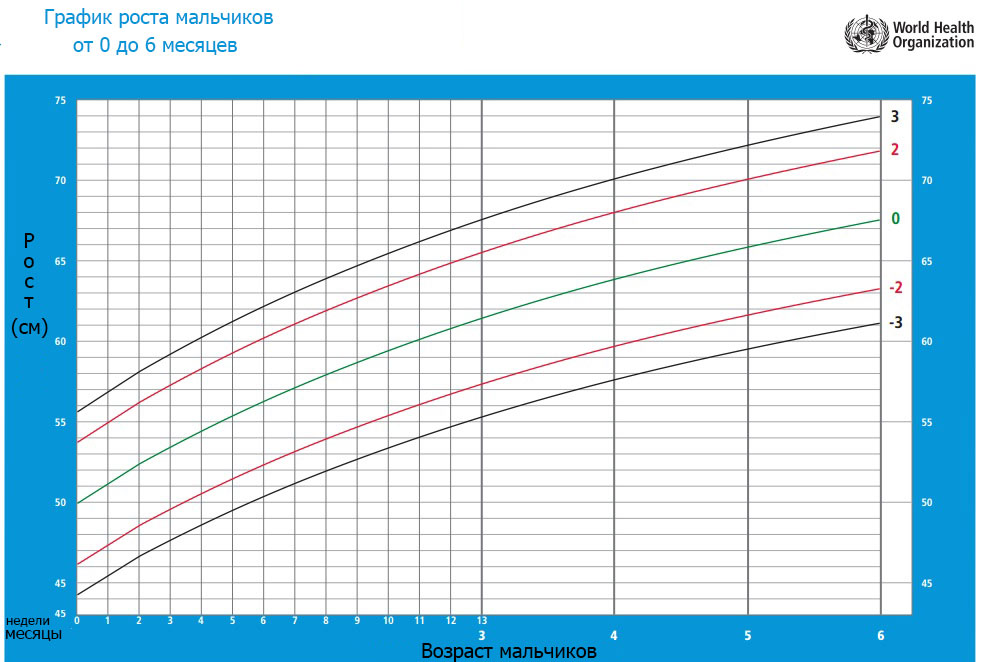
| Month | min. height (cm) | Max. height (cm) |
| 0 | 48 | 52 |
| 1 | 52 | 57 |
| 2 | 56,4 | 61 |
| 3 | 59,4 | 64 |
What should a child be able to do at 3 months
A child at 3 months old knows how to smile at family and friends. The part of the brain that governs the infant's hearing, some aspects of language, smell, memory, and emotions, begins to work actively. Physical activity increases and the baby gradually learns to show his emotions.
At three months, the child should be able to move more or less meaningfully with his hands. The baby is able to turn his head to a favorite voice or a familiar pleasant sound. Lying on the tummy, and fixes the shoulders, focus on the hands.
The grasp reflex in three month old baby more and more developing. The baby begins to gradually hold the rattle, grab the mother by the hair, fingers and pull it all into her mouth. During the crying of a baby at three months old, he looks at the reaction of his parents, whether mom and dad understood his desires correctly. When the baby does not like something, he stubbornly takes his eyes off the unwanted object.
What can a child do at three months
Play some light music or read aloud to 3 months old child. Children love to be sung to, especially a lullaby at night. Try singing and clapping your hands at the same time. There is a so-called "Mozart effect": including classical music, the baby calms down and this has a positive effect on mental development.

How much does a baby sleep at 3 months
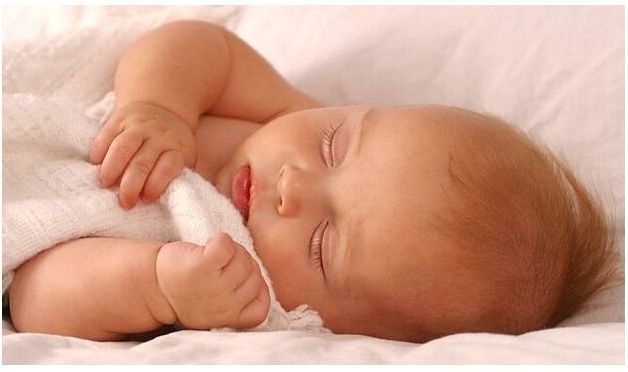
Three month old baby often wakes up in the middle of the night, but wait at least 30 seconds before approaching and comforting him. Babies at this age may cry at night, but quickly calm down. No need to run to the baby, otherwise he will never learn to fall asleep on his own.
Before going to bed, you need to feed a child at 3 months in the twilight, so as not to irritate the nervous system with bright light.
Daily sleep schedule is adjustable. At three months, babies usually sleep 1 to 2 hours a day at a time.
Baby at 3 months begins to feel the world. As his brain develops, he increasingly looks at everything around him with interest, even at his own reflection. Hold a mirror that doesn't break, or sit opposite one. The child will not at first understand that he is looking at himself. This will make him laugh a lot.
Physical development of a 3-month-old baby
To encourage your baby to exercise at three months, try putting him on his tummy. The baby will raise his head and shoulders up, using his hands for support. This small lift strengthens the muscles.
Advice! If you spend most of your time with your child, give your spouse a chance to strengthen the bond between them. It will also give you some time to relax and build your partner's trust.
There are many ways to encourage your husband to be alone with the baby and experiment. Remind him to remember his needs. If a child cries at 3 months, the husband may try to lean him against him, rubbing his back or give him a baby massage. Small children enjoy gentle and rhythmic movements. This will also give the partner the opportunity to feel able to soothe the child. Do not forget that breast milk is nutritious and healthy. You can express milk into a bottle and let daddy feed the baby.
spitting up baby at 3 months
Many three-month-old babies "spit up" most often after meals or even during feedings. After ten months of life, the frequency of regurgitation decreases. If the child burps no more than 30 grams, approximately 20 ml, this should not worry the parents, but otherwise you should consult a doctor.
3 month old baby spit up often and constantly after feeding
Below are the reasons frequent regurgitation at three months of age.
- The main reason for the constant spitting up of a child is overeating. There's nothing wrong with that, but you don't have to force yourself to eat.
- Keep the baby in a semi-upright position during feeding and for the next hour after feeding;
- It is not necessary to put the baby on the stomach within 30 minutes after feeding;
- You should not be active after feeding, turn the baby over, play active games or make you laugh.
If the baby at the age of three months began to spit up frequently in large quantities after each feeding, consult a pediatrician for advice. Do not wait for the time when the child will begin to lose weight, and the development process will slow down.
Without fanaticism, control the temperature of the child's body. One strong regurgitation a day is not a cause for concern.
Touching a 3 month old baby
Give your baby a gentle touch at three months. The kid blossoms from them and this is the key to proper development. Contact "skin to skin" strengthens the emotional connection with the baby, soothe him. Stimulate tactile sensation to different materials.
Try playing with a three-month-old baby with soft fabrics such as faux fur, felt, or a terry towel. Also, many parents believe that pets play important role in the development of the baby. But you need to keep animals safe, because they are one of the sources of the spread of lichen, fungal infection and wool.
How much should a child eat at three months
Infant formula, unlike breast milk, is digested much more slowly by a three-month-old baby. Therefore, such food should be fed less often. Over time, the child will eat and drink more, and the breaks between meals will become longer.
All this will also affect the sleep pattern: the baby will be able to sleep virtually all night without waking up. In the second month of life, the baby will eat approximately 110 or 140 gamma of food at each feeding. By the end of the 3rd month, the baby will eat another 30 grams more than in the second.
Overfeeding a baby at three months while bottle feeding is easier because breastfeeding is a difficult process. Be sure to give your baby as much as he needs, and the signs on the bottle will help with this. Fluid should drip slowly from the hole, not overflow. Also, resist the temptation to refill the bottle if your baby shows he wants more.
Never use bottles with support, they are not safe. With these types of bottles, you can easily fall asleep, which is not the best view sleep.
What happens to mom's life?
Mama still feel the anxiety and Bad mood, but pushes it to the nerves of the "newly made mother"? Most likely it is. One in four women suffer from it. Do not be embarrassed and do not be afraid to visit a doctor. This is a real, but completely curable disease.
This week's tip: When it's summer outside, this is a great opportunity to take your child for a walk. Lay a rug in the park or garden and the baby will enjoy stretching and kicking arms and legs. Baby's skin is delicate, so be sure to protect it from harmful effects sun.
At 3 months, it is better to avoid direct sunlight, as red spotted pimples may appear on the baby's skin. Choose a warm, shady spot, take a panama hat or umbrella, and sunscreen.
Breastfeeding: how much and how often?
During the three months of breastfeeding, over time, the amount of milk will decrease, and the baby will wake up less and less at night. You are offering enough milk if:
- child active
- Stably gaining weight, growing, developing
- If the child does not have enough food, he will be dissatisfied, fastidious, the baby will be annoyed. If you notice any of these signs, call your doctor.
Remember that after about a month, babies tend to go to the toilet less often. At two months, babies have a bowel movement after each feed. If the child has not pooped for three days, you should contact the pediatrician.
During periods of rapid growth of the child, the mother may notice that the baby wants to eat more often. During this period, the body of a nursing mother enters a special mode of increasing milk production, and after a couple of days, it should regain balance.
Exclusively breastfed babies should receive vitamin D for the first few days of life, and the mother should also give the newborn water, juice, but remember that solid foods are unacceptable.
After three months, you will realize that breastfeeding is second nature. This can come as a surprise and can be very frustrating if the baby refuses to breastfeed. But giving it up is common and shouldn't last long once you discover the cause.
What can a mother of a 3-month-old baby eat
Often mothers do not have enough time for good nutrition. However, no matter how busy or exhausted you are, it is worth starting the day with a nutritious breakfast. If you like to snack, try eating healthy, vitamin-rich fruits rather than cookies or chocolate.
MOTHER'S HEALTH = HEALTH OF HER BABY
Also remember to drink healthy drinks. A good diet while breastfeeding includes plenty of water. It can also be decaffeinated coffee. Stock up on nutritious snacks, especially fruits and raw vegetables, including cereals, yogurts, rice cakes.
Are your breasts inflamed, red, swollen, and sore?
In this case, you may have . Approximately 10 percent of nursing mothers suffer from mastitis. Continue to feed the baby, as the disease often arises from the overflow of milk in the breast. Stopping breastfeeding will only lead to worse outcomes. But also be sure to see a doctor.
The fourth month is a kind of Rubicon in the life of a baby. A three-month-old child has overcome the first stage of adaptation of the body to the outside world. What the baby can do at this point is the result of his work and the work of his parents. At three months, the development of the child goes in all directions (from physiology to the psyche).
At this stage great importance has timely and competent assistance in development from adults - these are massage and educational games, communication with the child and accustoming him to the daily routine, walks and changing feeding rules. To do everything right, parents must be mentally and informationally prepared for a new round in the life of their baby.
At 3 months, the baby begins to actively explore the world around him, memorize shapes, colors and sounds. It is desirable that parents during this period also make their efforts for the comprehensive development of the child.
There are many video tips on this topic, by watching which you can learn a lot of useful things for yourself (both in the field of child psychology and in the field of his physical development). It is better to watch material prepared by experts. For example, Dr. Evgeny Komarovsky tells in an accessible way what you should pay attention to.
Fundamentals of the physical development of the baby
The physical development of a child at 3 months has always been given great attention, especially by parents. This is partly due to the fact that they can easily determine the size of their 3-month-old baby, and thus assess his normal physical condition. The examination of a baby up to a year, which is carried out in a polyclinic at the place of residence, includes:
- general inspection;
- auscultation (the doctor listens to the work of the heart and respiratory organs);
- measurement of the volume of the chest and head;
- measurements of height and weight.
Baby at 3 months should weigh approximately 5 to 7 kg and have an average height of 62 cm (this applies to both girls and boys). All these parameters are influenced by the genetic characteristics of the parents, the fertility of pregnancy, its course and the period of its resolution ( ahead of schedule, on time or the mother carried the baby), as well as the conditions in which the baby grew up (nutrition - natural or artificial feeding, the introduction of early complementary foods and the quality of care).
Table of average sizes of crumbs by the end of 3 months:
Normally, a child gains from 0.5 to 1 kg per month at this age. Deviations are possible, for example, children who are fed with mother's milk gain weight faster than artificial ones. If the parameters of a 3-month-old baby differ from those declared, this does not mean that something irreparable has happened. When a child is cheerful, active and healthy, he poops 6-8 times per day and urinates up to 12 times, but a little underweight or overweight - this is not a reason for panic.
Babies who are breastfed by their mother rarely overeat, but mothers of children on artificial or mixed feeding should be attentive to the weight indicators of their crumbs. If it seems to you that the baby is plump or has excessive thinness, consult a pediatrician.
 In no case should parents ignore a scheduled visit to the pediatrician, since it depends further development child. It is important to identify whether everything is normal now, whether the baby’s reactions correspond to his age
In no case should parents ignore a scheduled visit to the pediatrician, since it depends further development child. It is important to identify whether everything is normal now, whether the baby’s reactions correspond to his age Reflexes of a newborn: what happens to them?
Basic reflexes of a newborn:
- Moro reflex;
- Babkin's reflex;
- search;
- proboscis;
- sucking;
- crawl reflex.
It is reflex activity that helps newborns survive and adapt to environment. But the baby 3 months no longer needs them. Therefore, normal the basic reflexes of a newborn at 3 months (with the exception of sucking and crawling reflexes) begin to fade, residual manifestations remain.
The presence of pronounced reflexes of a newborn may indicate a neurological pathology:
- opening the mouth and turning the head in the direction of exposure while stroking the corner of his mouth (search);
- extension of the lips with the proboscis when touched upper lip(proboscis);
- moving the head forward and opening the mouth when pressing on the palm of the child (Babkina);
- too pronounced Moro reflex.
Moro reflex at three months may indicate increased excitability nervous system babies. This reflex consists in a sharp throwing up of the arms and the opening of the palms. This is a reaction to a frightening factor (a sharp sound, for example). It can be summoned by hitting the table next to the child. Also during the neonatal period, it manifests itself when the baby is laid on his back, or when his legs are raised.
The crawling reflex and the sucking reflex are clearly expressed in ages 3-4 months. They are required for the growth and development of the baby.

At the 3rd month, babies often develop rickets, and parents should be very attentive to their baby. The first symptom is excessive sweating. The face of the crumbs is covered with droplets of sweat during feeding, but the head sweats especially strongly at night. The baby is worried about this, and he rubs his head against the mattress, because of which the hair on the back of the head falls out, a bald spot forms. Also, the baby becomes restless, shy, his urination becomes more frequent. All this may be due to a lack of vitamin D. At the first suspicion of rickets, an urgent consultation of a pediatrician is required, who will prescribe the necessary drugs and procedures, as well as correct the nutrition of the mother and child.
Skills that a baby masters by 3 months
- flips from back to stomach;
- "cobra" - the ability to raise the head and shoulders, leaning on the forearms.
A child at 3 months most often masters these skills, but far from all children do it well. Some people get over it by 4 or even 5 months. There are no strict standards here, the baby grows and develops, and does not pass the TRP. Therefore, if he is healthy, gains weight well, is active, has no neurological pathologies, but does not roll over very well and leans on his arms, you should pay more attention to training with him, developing games and massage.
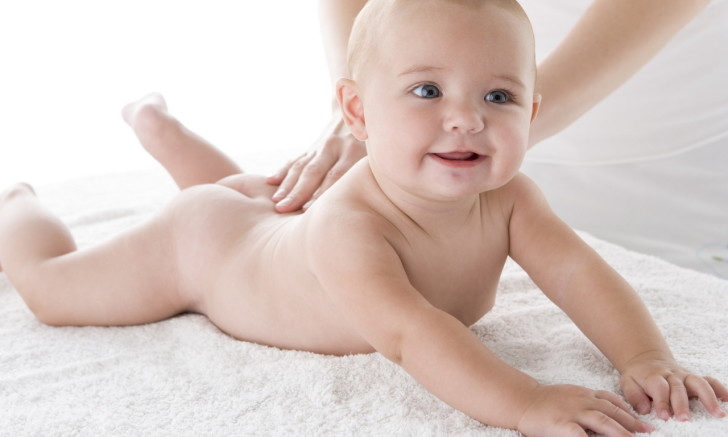 The ability to raise and hold the head normally develops by the age of three months. It is necessary as a base for further rolling, crawling and walking.
The ability to raise and hold the head normally develops by the age of three months. It is necessary as a base for further rolling, crawling and walking. Psychological characteristics of babies
Three months is a bright period of changes that affect the psyche of the baby, his emotional sphere:
- The main "novelty" in behavior is the so-called recovery complex. It consists in the active smile of the baby, raising his motor activity and in the fact that he “talks” for a long time (gurgles and gurgles).
- At this stage of a baby's life, the basic functions of his psyche, sensory perception, are actively developing. For example, vision undergoes a significant change. The child is able to track moving objects and objects with his eyes, to examine them.
- Object perception is formed. He is able to recognize a complex of properties of an object. To do this, he tries to use his sensory systems to the maximum (examine the object, touch, chew, shake, listen to the sound if it makes it).
- The child's hearing is also actively improved. The child is able to distinguish between intonations, isolate individual sounds from the general noise, and adequately determine the source of sound vibrations. He recognizes the voices of significant adults very well, the reaction to his mother's voice is especially noticeable.
- emotional sphere also progressing rapidly. A child at this age is able to be offended, surprised, upset. He sensitively feels the family atmosphere and the mood of adults.
- Learn by doing as you do. That is, by the method of imprinting, adopting and “writing down on the subcortex” the ways of responding adults.
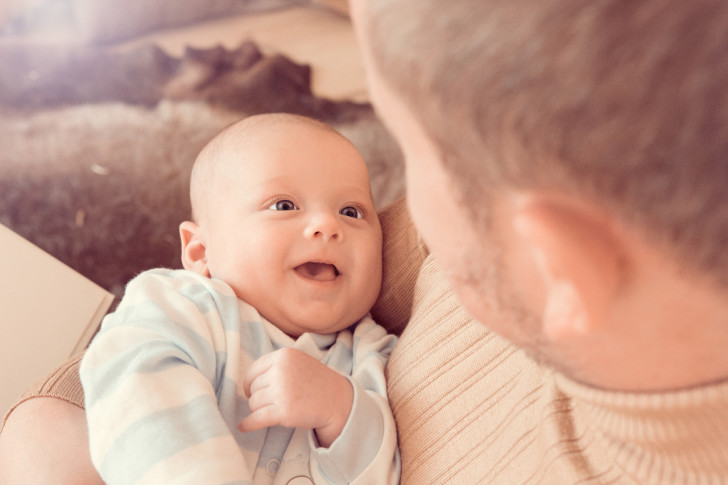 At 3 months, the baby begins to actively coo, as if talking. In fact, this is communication with parents - the child shares his emotions, shows affection or interest
At 3 months, the baby begins to actively coo, as if talking. In fact, this is communication with parents - the child shares his emotions, shows affection or interest Routine and nutrition
The three-month milestone is the time when it's time to take care of the baby, developing the basics of the daily routine from him and accustoming him to the main regime moments. By this time, the baby is still sleeping a lot, but already much less. A couple of decades ago, up to 18 hours a day was considered the norm, but modern children sleep much less. Toddlers can sleep from 12 ½ to 15 hours. The main time is at night. There is still up to 4 hours of sleep per day.
A three-month-old baby is able to sleep most of the night. During this period, the “correct” attitude to the baby’s night sleep is formed, that is, the association of the night with sleep. He should already learn to fall asleep not with a bottle or under his chest, but on his own. The place of eating and the place of sleep must be spaced apart; you should not feed the baby in bed.
The total volume of breast milk that the baby eats increases to 800-900 ml / day, in one feeding the baby eats about 150 grams. In general, breastfed babies regulate their own milk supply. If the baby is artificial, he should eat the mixture in the amount recommended by the manufacturer, large children can eat a little more. Some parents start introducing complementary foods at 3 months. We do not recommend doing this, it is better to postpone complementary foods for up to six months, in the case of IV - up to 5 months.
In the third month of feeding, one oflactation crises . This must be taken into account: in no case should you reduce feeding, assuming that the milk is “running out”. During this period, the flow of milk stops, and the woman thinks that there is less milk. In addition, the child shows interest not only in food, but also in surrounding objects: he can take breaks in food, looking around. Therefore, some mothers think that milk “disappears” and supplement their children with formula, this should not be done.
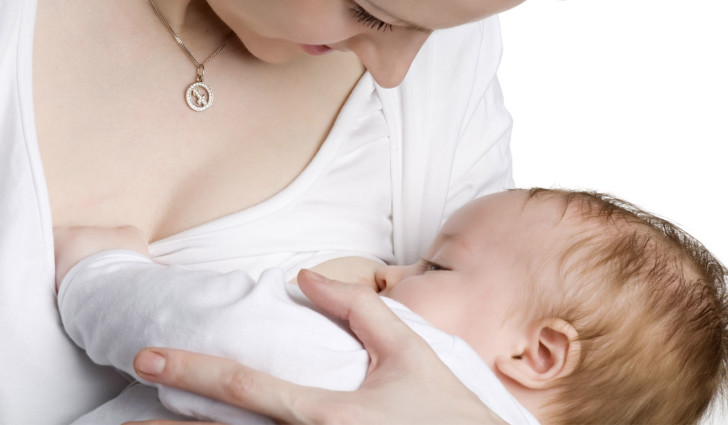 Sometimes mothers confuse a lactation crisis at 3 months with the complete disappearance of milk, which should not normally exist yet. The best tactic is to continue feeding, adjusting to the baby's regimen.
Sometimes mothers confuse a lactation crisis at 3 months with the complete disappearance of milk, which should not normally exist yet. The best tactic is to continue feeding, adjusting to the baby's regimen. "Developers" for the child
The 4th month of a child's life is the time when it is time to move on to active activities with him during periods of his wakefulness. Gamesthat mom can offer should be aimed at development:
- hearing (sing songs and nursery rhymes to the baby, read fairy tales in faces, turn on children's songs);
- speech skills (when talking with the baby, after saying a sentence, shut up, inviting him to insert his “phrase” in this way, over time the baby will understand, and will be happy to participate in such a “dialogue”);
- tactile sensations(you can give the baby objects of different textures to feel them, for example, cereals, different fabrics, objects with an unusual surface, etc.);
- stimulate brain activity in a reflex way (massage of the palms and feet, finger exercises, etc.).
Toys for a three-month-old baby should be chosen bright, colorful and comfortable for grasping and biting. Very well suited different rattles with rings. Pediatrician Komarovsky will tell you about this in an accessible and detailed way in his programs, as well as a video on the development of the crumbs according to the Leonardo method:
Behind were three months from the time you brought the crumbs from the hospital. And if the first stretched, was full of worries, then the second and third flew by unnoticed, because the baby is growing and becoming more and more interesting. What can a child do at 3 months? Let's highlight his main achievements.
Physical parameters
Every month, when you come for a routine examination at the clinic, the baby must be measured for height and weight. Many pediatricians rely on numbers taken from tables, and to a greater extent this is reasonable, since it allows you to see the dynamics of development as a whole.
Normal at 3 months:
- weight is from 4.5 to 6 kg (an increase per month is about 600-800 grams);
- height from 56 to 64 cm (an increase of 2-3 cm per month).
However, there are many factors that can affect the results obtained. These include height and weight at birth, genetic characteristics, type of feeding. So, it would be wrong to focus only on the tables compiled for artificial people when the mother is breastfeeding. When breastfeeding, weight gain can vary from 500 g to 2 kg per month. If the weight gain is small, it is worth consulting with a specialist in breastfeeding: perhaps the technique of attachment to the breast is broken or the feeding itself does not occur on demand.
Important criteria for a discrepancy with the tabular weight are the general condition of the baby, his activity, interest in the world around him, as well as the fact that the child eats with appetite, urinates well (at least 12 times a day) and poops (about 6 times). If all this is observed, do not worry about the numbers on the scales.
Dream
Children at this age begin to understand what the regime is, and at the same time sleep for quite a long time: about 10 hours at night and about 7 hours during the day, divided into 3-4 intervals. In total, the child should sleep 17 hours a day. daytime sleep just as important as the night.
Baby's sleep still takes up most of the time
Bathing and walking
The baby should be outside as often as possible. Fresh air is an excellent prevention of respiratory diseases, benefits the cardiovascular system. Take your child in your arms from time to time while walking, thus providing him with maximum visibility.
The baby likes bathing more and more, especially if bright toys have appeared in the water. The requirements for the procedure remain the same: you can bathe at any time of the day, but it is better before evening feeding. In conclusion, it is recommended to rinse the child with water 1 degree lower than the one in which they bathed.
Changes in physiology
By this time, the head has become more proportional in relation to the body. Intensive growth continues, and during this month the crumb will stretch another 2-3 cm.
The digestive system has also changed. The stomach increased by 2 times, which explains the increase in portions of food consumed and lactation crises at this time. Continue to continue to feed your baby only breast milk, applying to the breast more often, and after a week the feeding regimen will return to normal. The nutrition of a nursing mother must still be balanced.
If the 3rd month of life is not on summer period when you can get sunbathing naturally, a pediatrician may prescribe vitamin D drops to prevent rickets. Do not neglect this recommendation.
The coordination of movements becomes more perfect: the baby consciously takes the toys in his hands, examining them, examines his face with the help of his hands, rolls over. It is just as important to do gymnastics and exercises with the baby.
reflexes
Some reflexes remain only for three months from the date of birth, others accompany the child all his life. By the time of appearance and disappearance of temporary reflexes, it is possible to determine whether the baby is lagging behind in development. At this time, the following are observed:
- proboscis reflex. The kid pulls out his lips in the form of a proboscis, if his fingers seem to tap on his lips.
- Sucking reflex. The baby is actively sucking on the pacifier.
- grasp reflex. Put your finger in the baby's palm - he will grab it tightly. A similar picture, but with less force, is observed when pressing the sole between the second and third fingers - the foot is compressed. The reflex fades by 4 months.
- Search reflex. Stroking the corners of the lips, you will see how the baby turns his head in response to irritation and opens his mouth. This reflex is very pronounced when the baby wants to eat.
- Moro's hug reflex. Its essence is that when patting on the table or on the thigh, as well as with unexpected noise, the baby takes his hands to the sides and unbends his fingers, after which they return “to their place”. From the side it seems as if the child is trying to hug.
- Support reflex. Holding the crumbs by the armpits leads to the fact that he bends the legs in all joints. But as soon as the soles of the feet come into contact with a hard surface, he begins to rest with a full foot and makes movements similar to walking.
- Bauer's crawling reflex. The child lies on his stomach, palms are attached to the soles of the feet. As soon as he feels the support, he will try to push off and crawl.

Reflexes play an important role in assessing a child's development
Core Skills
We can say that the development of a child at 3 months reaches a certain milestone, when the first results of his own success are summed up. The baby becomes more and more active. The skills of the child are manifested as follows:
- Baby confidently holds his head, lifts her from a position lying on her stomach, tosses her around. At the same time, he leans on his forearms, his palms are more often open than gathered into fists.
- Rolls from belly to back or sideways. If you observe that the child makes such an attempt, help him. Show the rattle within his line of sight, but slightly out of the way. The baby will first turn his head to the sound, then his shoulders and torso.
- Laughter and smiles will now please you more and more often. For the first time, a baby can laugh contagiously at exactly three months, for example, from the fact that dad sneezed loudly. The baby loves to talk very much, of course, while in his own language, but the humming of babies delights the ears of not only parents, but also almost all the people around him.
- Can't stand long periods of loneliness. How else! After all, the child begins to realize what society is, listens with attention to an adult conversation. Therefore, if mom is not around for some time, he will confidently declare his dissatisfaction.
- Hearing is already well developed, so if close person comes up behind and speaks, the baby will turn his head in his direction and will be able to find him with his eyes. A child at 3 months is able to distinguish voice intonations and respond accordingly: to affectionate speech - with a smile and animation, to reproach in the voice - with alertness and crying.
- Grabs toys with hands. At the age of three months, a baby has already formed binocular vision, which makes it possible to give a correct assessment of the distance at which an object is located. Therefore, the baby is happy to hit the hanging toys with his hands, captures large bright objects.
- Pens in the mouth - the usual picture. Since the hypertonicity of the muscles that constrains the movements of the palms is behind, the hands become one of the first objects to be examined through the mouth.

Bright toys are very attractive
Games and gymnastics
Fitball training. Lay the baby on the ball with his stomach, holding the back with one hand, grabbing the thigh with the other. Roll it back and forth, left and right, while pronouncing all your actions.
An exercise that stimulates coups. The baby lies on his back, lift his right leg by the shin and move it to the left, as if throwing it. This is the most difficult moment in the coup for him. It is also worth performing the basic set of exercises recommended by pediatricians for this age.
Toys that are different in size and touch. Let's hold different toys for the baby geometric shapes, animal figurines, smooth and embossed objects. This will stimulate finger development.
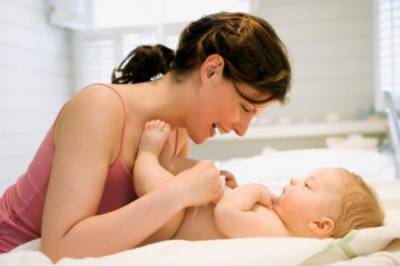
Gymnastics should be practiced from birth
Finger gymnastics. Massage of the palms and fingers should take place in the form of a game with nursery rhymes and rhymes. Suitable "forty-crow" or "girls and boys have 5 fingers on their hands."
Ku-ku, my bunny. Yes, children are very fond of playing games where parents cover their faces with their hands and then cuckoo. The main thing is not to skimp on positive emotions. You can play hide and seek by covering your face with a handkerchief and asking: “Where is mom?”
Who says what. It will be very interesting for the baby to listen to how a cow mooes, a dog barks or a cockerel sings in your performance, so diversify your activities with your baby with similar sounds.
In classes with a child, it is very important to maintain eye contact and explain all your actions in words. Sing songs more often, speak short phrases into rhyme. Communication has a significant impact on a child's behavior, so whether you're walking in the park while your baby is awake or changing a diaper, talk to him as often as possible.
Every day the child's skills become more and more meaningful. And it's a great happiness to see how little man day after day he explores himself and the world around him, learns something new.
With the advent of a baby, young inexperienced parents have a lot of new worries and troubles, so often new moms and dads resort to special literature and advice from older comrades to solve incomprehensible issues. The development of a child at 3 months is quite active, so this time should be used as efficiently as possible, because right now the basic skills and habits are being laid.
Physiological changes
In the very first months of life, newborns develop very intensively, changes affect all organs and systems of the body. During this month, the child will grow by about 2-3 cm, and the head will acquire a more proportional size in relation to the body.
Actively progressing digestive system, the stomach by this time increases at least twice, so the newborn needs more breast milk. In addition to the mother's breast, a child of this age does not require additional nutrition, the only supplement acceptable for 3 months of life is vitamin D prescribed by a pediatrician, which prevents the development of rickets. Gaining weight on early stages should be given more attention, because given period there is a high probability of overfeeding the baby, especially for babies who are on artificial feeding. The optimal weight gain for 3 months is 600-800 grams, however, it should be noted that this is an average figure, and it may vary depending on the characteristics of the organism.
By 3 months, coordination of movements is being established, the child already consciously takes toys with his hands, can clap his hands or reach for his face. Most newborns are able to roll onto their side or tummy by the end of 3 months. The most active children may attempt to pull themselves up with their hands and rise a little. The task of the parents at this stage is to help the baby perform the desired action, however, it is impossible to lean the newborn on the legs or let go of the hands abruptly, since the ligaments of the limbs are not yet fully developed, therefore they are not able to withstand the weight of the baby.

Psychological development
Every day of life, newborns develop new skills and abilities, children spend less time in a dream, and more and more learn about the world. It is during this period that many babies tend to be in the arms of mom and dad as often as possible, as this allows them to see more interesting things around.
A child at 3 months easily perceives sounds and freely distinguishes native voices. He already turns his head on hearing his name, can focus on small elements and follow moving objects with his eyes. This is a good time to teach him to calm music, for example, classical works or children's songs. You can use a crib mobile, which will give mom a little more free time. Spinning rattles and toys, together with light music, will occupy the baby for a while, and gradually the child will fall asleep on his own with the help of such a simple device.
Not yet able to speak, at this age the child gives signals to parents, with the help of which one can understand his condition. During 3 months, by crying a child, it is already possible to distinguish the cause of his discomfort:
- slight sobs, gradually gaining momentum and eventually turning into a loud cry, most often mean that the child is hungry;
- crying in a dream, during which the baby is spinning or rubbing his hands, is a sign of lack of sleep, in which case it is best to create silence in the room and rock the child;
- piercing and sharp crying, most likely symbolizes painful sensations. The third month of a newborn's life is accompanied by colic and otitis media, therefore, first of all, attention should be paid to the baby's ears and tummy;
- evening crying, starting at the same time, may indicate intracranial pressure. The solution to this problem is the use of a pacifier, which will remove discomfort and comfort the newborn.
Being in a good mood three month old baby will actively roar and laugh. Every day, the sounds uttered by the baby become more distinct and varied, it is possible to enhance the speech activity of the newborn at this time with the help of songs and poems. By the way, soon the baby will begin to distinguish phrases already familiar to him, which he will inform you about with a joyful exclamation, and having learned to speak, he may surprise you with an independent repetition of the studied material.

What to do with baby
A child at 3 months is quite active and mobile, tends to turn around, move his arms and legs, so this time is the most suitable for active games. Of course, the baby still does not know how to crawl or sit, so active activities with him should be as follows:
- study of hanging toys - by hanging several different rattles or soft animals in the arena, you will give the baby the opportunity to independently carry out gymnastic exercises. The child himself will try to get objects first with his arms, then with his legs, which will significantly strengthen his muscles;
- morning exercises - after the morning bath procedures, a little gymnastics will be useful. Gentle flexion and extension of the arms and legs promotes the development of ligaments, and turning movements of the torso from the back to the tummy will help the baby learn to roll over without your help. When conducting gymnastic exercises, one should take into account such an indicator as the weight of a child at 3 months, since cardinal deviations from the norm require special classes;
- massage - light stroking of the back and neck area will avoid muscle stagnation, and light massaging of the knee and elbow joints will increase muscle elasticity;
- outdoor walks - take the baby for a walk as often as possible, children of the 3rd month of life are very interested in observing the outside world, for example, animals, plants, etc. To make the baby more interesting, slightly raise the back of the bed or take the child in your arms more often, giving him the maximum outlook;
- fitball exercises - a soft elastic ball for physical exercises allows you to coordinate the movements of the child, while it is considered an excellent prevention of intestinal colic.
At three months, the baby takes pleasure in new games and activities. This is a good period for the development of tactile sensations, which will help homemade toys. Offer your newborn a few soft objects of different textures, such as velvet soft toy, a harsh kitchen glove and a ball made of dense threads - by touching different surfaces, the child develops hand motor skills. Soft cubes with a rattle inside are also popular. Take a few ordinary cubes and one with a rattle, show the baby the difference between them. Soon the baby himself will find a rattling object from the mass of the rest.
At three months, the baby will be happy to meet other children, they, of course, will not be able to play together, but they will get a lot of new experiences. If you have pets at home, do not limit their communication with the child, of course, under your strict control.
Since the baby of the third month is able to distinguish sounds and familiar objects, it will be interesting for him to observe himself. To do this, hang a safe mirror in the arena, the baby will definitely appreciate this innovation.
Try to introduce your child to different styles music, turn on rhythmic songs during the waking period and accompany them with clapping your hands, as well as light dance moves. Before going to bed, it is better to put on calm music, and soon the child will distinguish the relationship between the rhythm of the music and subsequent actions.
Such simple exercises help the correct and active development of babies of the third month, in addition, children who receive a lot of attention from their parents grow smarter, develop faster than their peers and get sick less often.
